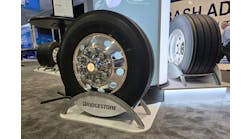This is Part One of a two-part story. Click here to read Part Two.
When Austin White and his partners decided to buy a heavy-duty repair shop in 2019, they wanted to put a modern spin on things and grow the business. After purchasing a truck and trailer repair shop called JECO in Denver, ownership rehabbed how personnel were managed. They started an apprentice program, hired a full-time trainer, and installed technician incentives. Then they worked on branding, changing the shop name to Iron Buffalo Truck & Trailer Repair.
With their initial mission accomplished, a new problem emerged. Those successful changes led to more business, and Iron Buffalo had outgrown its space.
This is a good problem to have, but one that needs solving nonetheless. With the transportation industry in a historic time of change, where the needs of both vehicles and technicians will be very different in the next decade versus the previous one, shops’ plans for expanding or refreshing existing facilities and adding new ones also need to be reevaluated.
Picking a new location
Iron Buffalo intended to find a property they could get a decent deal on and purchase. Unfortunately, the hot commercial real estate market around Denver was making that rather difficult. Eventually, White found a suitable building the repairer could lease. Operations moved into that building late last year, effectively doubling their square footage to 40,000.
While that expansion was coming together, the opportunity to open a second shop came about. White’s general manager in Denver had informed him she was moving roughly 1,000 miles away to Kalispell, Montana—and would have to resign. White had a different idea.
“I did some research and discovered that Kalispell was a much smaller market, but also an underserved market,” White said. “So I asked our general manager if she would be interested in helping us open a shop there. She agreed. We started off just doing mobile repairs to help get our name out. I think it’s going to work out pretty well.”
White said in just a few months, the new shop surpassed its eight-month goal.
“Now we’re moving into a brand-new building that we’ll also be leasing,” he said. “We’re excited about the potential up there.”
Red tape and real estate
Iron Buffalo’s expansion into Montana happened somewhat unexpectedly. It also came together rather seamlessly. Switching locations in Denver took a little more work, but White said he learned some valuable lessons about leasing property.
Read more: Designing your shop
“Make sure you do your own homework,” White said. This is particularly important when dealing with an absentee landlord. “I never thought we’d have to help a building owner navigate local building codes. But some of these investment firms are so big and own so many properties that they just don’t know sometimes.”
Shortly before the lease papers were signed, the building owner told White he wouldn’t be able to store hazardous materials on site. This puzzled White because the previous tenant had also operated a repair shop. He immediately got in touch with local zoning officials to explain what he was looking to do with the building. “Thankfully, everything turned out to be fine,” White said.
Recognizing this red tape red flag, White proactively scheduled a meeting with the water department to make sure nothing was being missed there. It’s a good thing he did.
“We found out we needed secondary containment on every bulk fluid in the building,” White said. “It sounded scary at first. But once we sat down with the water department officials to see how we could go about doing this, we realized they were more than willing to help us.”
Ironing things out with local zoning officials can be an even bigger undertaking when building a new shop from the ground up. “Getting all the necessary permits and approvals can take longer than building the actual building,” said Joe Gonzales, president and co-owner of Guzman Automotive, an automotive service company that provides fleet services for vehicles up to Class 6.
Guzman Automotive’s flagship location in Taylor, Texas, was built less than a year ago. “When it comes to planning and zoning red tape, it’s best to let the professionals handle it,” Gonzales said in reference to working with an experienced builder, with emphasis on the word experienced. “They do this kind of thing all the time and know just what to do.”
Inspired by the success they’ve had in Taylor, Guzman Automotive is now looking to build two more shops over the next year or two. Gonzales is narrowing his hunt for properties based on several criteria. First, a two-acre lot would be ideal to build a sizable shop and provide ample parking for the types of vehicles they service. Secondly, Gonzales wants to pick locations where the business can thrive.
“I make it a point to speak with county and local officials to see if a certain property we’re looking at is in a high-traffic area, or expected to become one in the future,” Gonzales said. He’s also assessing the current level of auto services in the area. One location he’s evaluating is in the midst of an industrial boom, which could lead to an opportunity to establish a shop that is more skewed toward fleet services.
To secure funding for the expansion, Gonzales reached out to a local bank. His family had previously owned another repair business that it sold for a nice profit. “We’re not using any of that cash to help with this expansion,” Gonzales pointed out. “But I am leveraging it in working with the bank. I can point to that and say, ‘Look at what we’re capable of accomplishing.’ When the bank considered that while looking at the business plan I’d created, along with the growth potential of the areas we are looking to build our new shops in, they were very supportive.”
From concept to construction
When the time comes to build Guzman Automotive’s two new shops, they will be patterned after the flagship location. They’ll be built by the same contractor, too, who already understands how to bring that concept to life. Gonzales said they initially chose that builder because he had a long resume of designing and building dealership service centers.
Taki Darakos, VP of vehicle maintenance and fleet services at Pitt Ohio, a less-than-truckload carrier, said expansions are much easier when you have strong relationships with contractors and other partners who can help refine the concept in a practical way.
“Pitt Ohio has developed relationships with general, electrical, and construction contractors, along with appropriate engineering firm support,” Darakos said. “Over time, you come to understand how each other works and what is needed from the get-go. It’s important to develop that working rhythm.”
Pitt Ohio, which provides transportation services in 14 states throughout the Northeast, Mid-Atlantic, and Midwest, typically has multiple renovation projects underway at once. When refreshing a maintenance facility, concept creation requires coordination across several groups, including vehicle maintenance, operations, IT, safety, finance, and C-level executives.
“Everything starts with a site drawing and goes from there,” Darakos said. “Not everything makes it to the finish line, but we work together to come up with the best fit. The tight coordination is so critical that we have a weekly recap call to try and minimize anything slipping through the cracks.”
To learn more about the process of designing, building, and moving into a new shop, see Part Two of this story when it becomes available.






